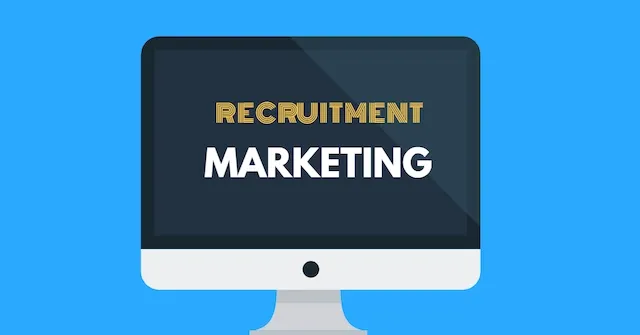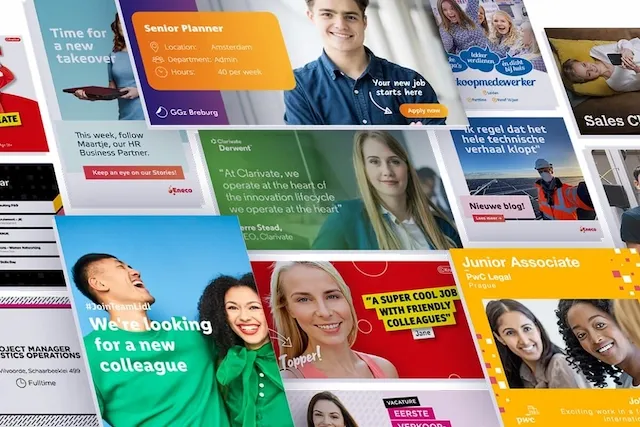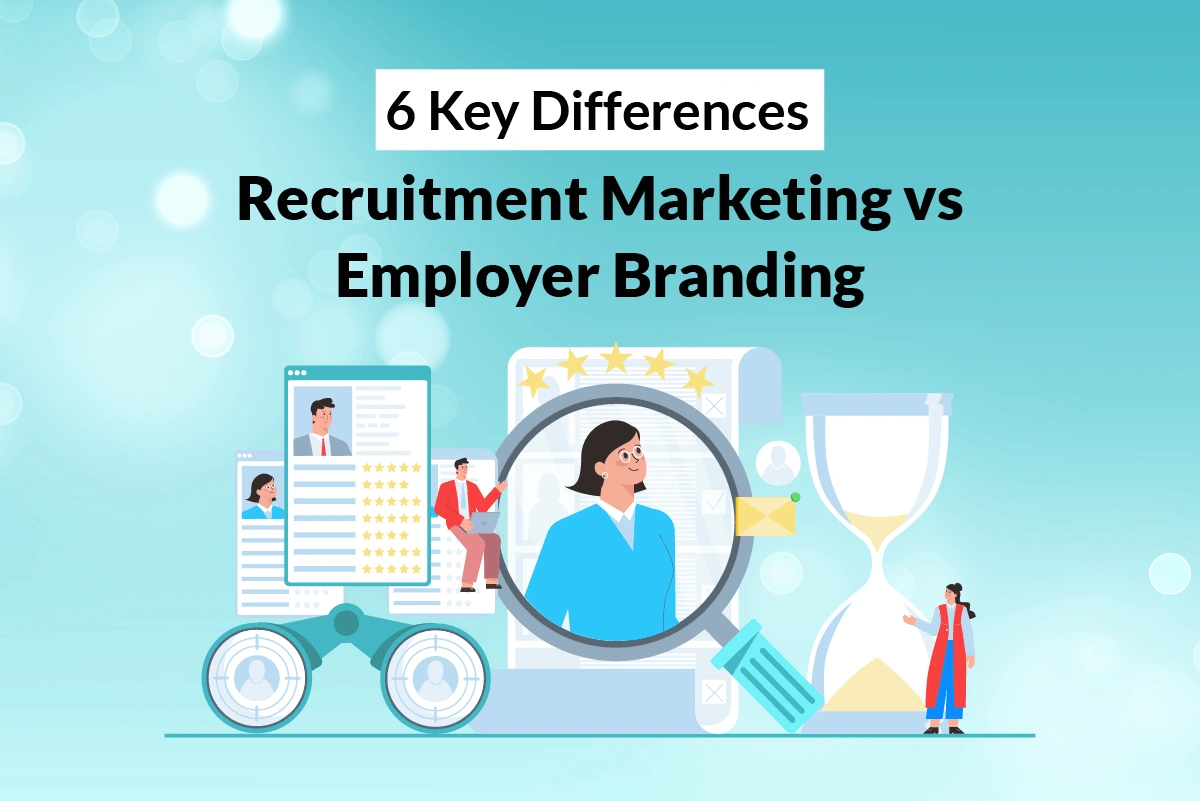Recruitment Marketing and Employer Branding are related but distinct. Recruitment marketing is about attracting top talent through marketing, while Employer Branding focuses on shaping and enhancing your organization’s reputation as an employer, similar to how a corporate brand defines its value in the marketplace.
This article will help you consider each term to grasp what these concepts mean and learn how to employ them effectively.
What is Recruitment Marketing?

Source: LinkedIn
Recruitment marketing refers to the technique of attracting talented individuals to your company by marketing to them. The primary objective of recruitment marketing is to encourage people to submit applications for the vacant jobs your organization is currently hiring for. In most cases, recruitment marketing is the first step of talent acquisition.
Recruitment marketing is essential because it enables businesses to draw in and keep top talent in an environment of fierce job competition. Conventional recruiting techniques can no longer attract the attention of qualified applicants. By taking a proactive strategy, businesses may differentiate themselves from the competition, establish a solid reputation, and eventually attract the most qualified candidates for their staff.
In short, recruitment marketing uses typical marketing techniques for hiring purposes: to attract potential candidates, not customers, and to promote the employer brand of the company, not the commercial brand.
Overview of Employer Branding

Source: EKRUT
According to research by LinkedIn, 75% of applicants will research your company before applying for your job opening. And 69% of applicants won’t apply if they don’t like what they see, even if they are jobless!
So what is employer branding, and why does it have such an effect?
Your employer branding is your business’s reputation as an employer. Simply put, it’s what potential employees and coworkers really think of you. It’s what they tell their friends and family when you aren’t there. Your employer branding is a valuable asset that needs ongoing maintenance, even if it is not physically present.
Employer branding serves two purposes. On the one hand, it’s an internal plan to increase staff recommendation and retention rates. On the other hand, it’s an external strategy to draw top talents to your company via presenting your company culture, values and benefits to the world.
In other words, employer branding is more than just a marketing tactic. In a talent battle, it is your company’s competitive edge. Simply, focusing on employer branding helps highlight all the positive things about your business to prospective candidates.
Demystifying Recruitment Marketing vs Employer Branding

Source: Lets Evolve
Conceptually, recruitment marketing vs employer branding seems akin to one another. However, you shouldn’t utilize them interchangeably. So what are the main differences between these terms?
Follow the table below to get the critical points about the key differences between recruitment marketing and employer branding!
|
Aspects |
Recruitment Marketing |
Employer Branding |
| Focus and Objectives |
Attract and engage potential candidates |
Shape and enhance company’s reputation as an employer |
| Target Audience |
Active and passive job seekers |
Potential candidates and current employees |
| Time Horizon |
Short-term, campaign-driven |
Long-term, continuous |
| Messaging and Content |
Job-specific information, benefits, qualifications |
Values, culture, work environment, employee experiences |
| Channels and Tactics |
Social media advertising, job boards, career fairs, emails |
Company website, social profiles, employee testimonials, PR initiatives |
| Measurement and Success Metrics |
Specific, easy to measure |
General, harder to measure |
| Key Focus |
Immediate hiring needs |
Building a sustainable branding image |
Focus and Objectives
Through specialized marketing techniques, recruitment marketing mainly aims to draw in and keep interested applicants. It attempts to raise awareness of employment prospects, advertise the employer brand of the business, and spark interest among qualified people.
Employer branding, on the other hand, focuses on forging and strengthening the business’s image as an employer of choice. Recruiting and retaining top personnel entail exhibiting the company’s principles, culture, and employee experience. In other words, a business’s recruiting marketing approach relies heavily on employer branding.
Target Audience

The target market for recruitment marketing includes both active and passive job searchers. The objective is to draw in both active job seekers and those who may not be actively looking but could be interested in the organization.
However, employer branding puts equal emphasis on present workers and prospective hires. It focuses on creating a positive perception among job seekers and reinforces the company’s image among existing employees.
Time Horizon
Recruitment marketing is often campaign-driven and time-limited with particular employment requirements in mind. It is consistent with short-term recruiting objectives and may change based on the hiring cycle and demand of businesses.
In contrast, employer branding adopts a longer-term strategy. It focuses on establishing a favorable employer brand that can continually draw talent and cultivate a solid reputation over time.
Messaging and Content

The language and content of recruitment marketing are focused on details about particular jobs, such as job descriptions, requirements, and perks. The information is designed to appeal to prospective applicants and persuade them to submit applications for specific opportunities. The messaging focuses on immediate job opportunities and the value proposition for applicants.
Employer branding emphasizes broader messages regarding the organization’s beliefs, work culture, and employee experiences. The content is designed to promote the employer brand and foster a favorable perception of the business as a whole. The messaging aims to establish an emotional connection with potential candidates and convey the business identity.
Channels and Tactics
Various methods and channels are used in recruitment marketing to connect with prospective applicants efficiently. This might involve targeted email marketing, job boards, career fairs, and social media advertising. The choice of channels and tactics depends on the target audience and the specific goals of the recruitment campaigns.
Learn how to use social media as a recruitment tool.
On the other hand, employer branding focuses on a unified message across several platforms, including corporate websites, social media accounts, employee reviews, and PR initiatives. The objective is to have a consistent and powerful employer brand presence that connects with prospective applicants at several touchpoints.
Measurement and Success Metrics

In recruitment marketing, success is often assessed by metrics such as the number of qualified applicants, time-to-fill the positions, cost-per-hire, candidate engagement levels, and conversion rates. These metrics help assess the effectiveness of specific recruitment campaigns and strategies.
Employer branding success, however, is measured through criteria like employer brand perception, employee happiness, retention rates, and applicant attraction and conversion. These metrics are often considered harder to measure since evaluating the result takes a long time. Yet, the key emphasis is on the long-term impact of branding initiatives on the business’s overall reputation and talent acquisition results.
Conclusion
For businesses looking to attract and retain top talent, it is essential to understand the significant distinctions between employer branding vs recruitment marketing. There’s no one-size-fits-all approach for promoting your business image to attract potential talents.
With the help of Boulo, your business can optimize the recruitment process and quickly achieve employment objectives. Whatever direction you decide to take, ensure that your recruiting strategy highlights the qualities that make your business unique while delivering the information in a clear and exciting way.
Contact us now to maximize your chance of getting the top talent!

